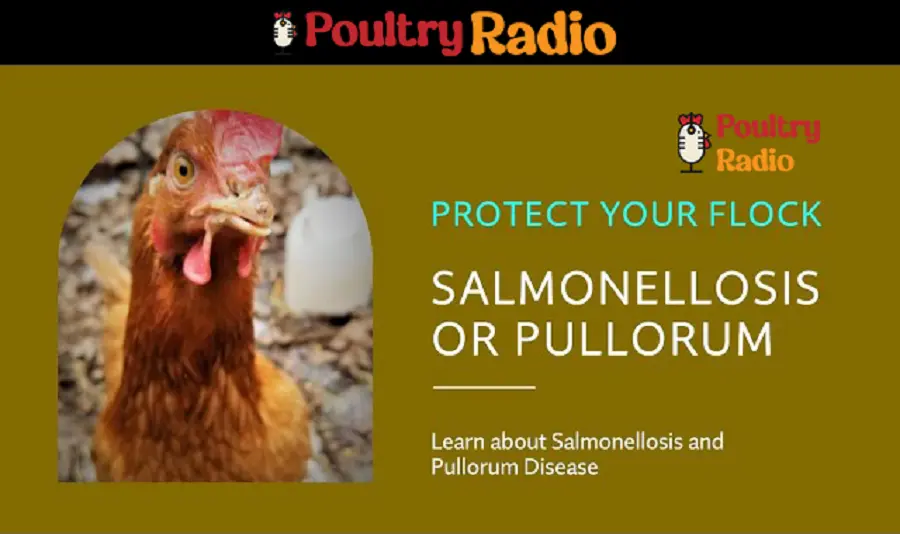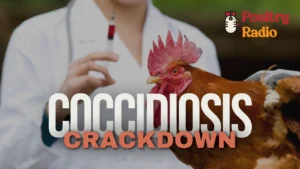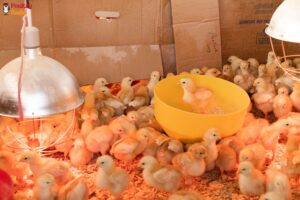Poultry Pandemic: How to Detect and Protect Salmonellosis in Poultry
Salmonellosis (in poultry) is a bacterial disease caused by various strains of salmonella bacteria. It can affect poultry including chicken and turkey. Due to its potential effects on bird health, food safety, and public health, it is a major concern in the poultry industry.
Transmission of Salmonella Disease
Salmonella can be transmitted between flocks or within the flock both vertically and horizontally (Like in the case of Mycoplasma).
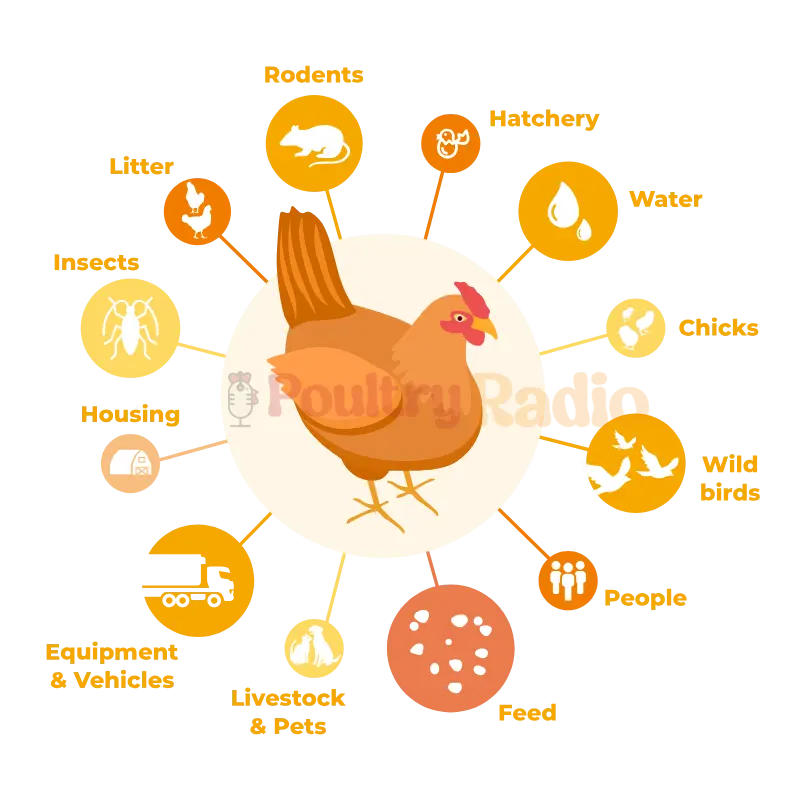
Vertical Transmission:
Through infected hen: Salmonella bacteria can enter a hen’s ovary and oviduct, which are reproductive organs responsible for egg development. Before the eggshell forms, the bacteria can inhabit these organs and affect the developing eggs.
Horizontal Transmission:
Between flocks: Through contaminated animal feedstuff (meat meal, bone meal, fish meal), Rats, mice, Reptiles, Flies and scavengers (dogs, cats).
Within a flock: Feco-oral transmission, Cannibalism (vent picking/ prolapse), and egg eating (in adults)
From hatcheries: Infected eggs, egg trays, dubbing, de-toeing, syringes, etc.
There are three major diseases in poultry caused by different salmonella species.
- Pullorum disease
- Fowl typhoid
- Paratyphoid
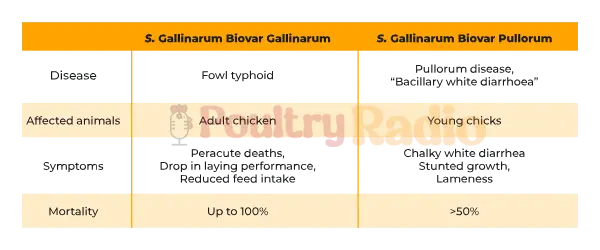
What is Pullorum disease?
Its causative agent is Salmonella Pullorum (Gram-negative and non-motile). Transmitted through both ways, vertically and horizontally. This Infection also transmitted via egg or hatchery contamination, usually results in death during the first few days of life up to 2–3 weeks of age.
Clinical Signs of Pullorum Disease
- Sleepy (somnolence) and weak.
- Shrill cries while excreting feces.
- Huddle near a heat source.
- Whitish (chalk white) fecal pasting around the vent (diarrhea).
- Such hens lay eggs, some of which hatch and give birth to diseased offspring.
Gross Lesions of Pullorum Disease
There might be no lesions (due to acute septicemia and death).
Lesions in Young Birds
- Unabsorbed yolk sacs
- Typical gray necrotic nodules in the liver (petechial hemorrhage/congested and focal necrosis), spleen, lungs, heart, gizzard, and intestine.
- The spleen is enlarged or swollen.
- • The mucosa of the lower intestine can occasionally develop elevated plaques and cheesy material in the ceca.
- Peritonitis
Lesions in Adult Birds
- Nodular pericarditis (development of nodules or granulomas on the pericardium).
- Fibrinous peritonitis (the accumulation of fibrin and inflammatory exudate in the peritoneal cavity).
- Ovarian follicles become hemorrhagic, atrophic, and regressing with caseous contents.
- Ascites (accumulation of fluid in the abdominal cavity due to liver dysfunction).
What is Fowl Typhoid (Klein disease, infectious leukemia)?
Fowl typhoid also known as avian typhoid caused by salmonella Gallinarum. It is an Acute septicemic disease, more often in adults or growers, characterized by profuse bright Sulphur diarrhea, sleepiness(somnolence), and anemia of combs and wattles.
Clinical Signs of Fowl Typhoid
- Fowl typhoid can be chronic or acute.
- Clinical symptoms and postmortem lesions in young birds are similar to those seen with S pullorum infection.
- Older birds may be anemic (pale comb and wattle).
- Dehydrated.
- Diarrhea (bright yellow splashes).
- Mortality varies 5%-50%. (Increased by mismanagement)
Gross Lesions of Fowl Typhoid
- Swollen (enlarged), friable, and often bile-stained (bronzed) liver, with or without necrotic foci.
- Enlarged spleen and kidneys.
- Anemia (Normal PCV is more than 30).
- Enteritis (anterior small intestine often with ulceration).
- Degenerated, misshapen ova.
- Broken egg yolks. (Also seen in Colibacillosis)
Paratyphoid
Avian paratyphoid is caused by different Salmonella strains, including Salmonella Typhimurium, Salmonella Enteritidis, and others. Paratyphoid infections are of public health significance (zoonotic) via contamination and mishandling of poultry products.
Clinical Signs of Paratyphoid
- Depression, sleepiness, poor growth, weakness, diarrhea followed by dehydration, pasting/wetting of vent area, dropped wings, shivering, and huddling near heat source are hallmarks of the disease, however, these clinical signs are not distinctive.
- Mortality is most often limited to the first few weeks of age (less than 4 weeks of age).
- High morbidity and mortality (vary from 30 to 90 %) during the first 2 weeks of age.
Lesions
- Swollen mottled liver & spleen with focal necrosis.
- Unabsorbed yolk sac (also seen in colibacillosis).
- Enteritis can be seen with necrotic lesions in the mucosa and cecal cores.
- Myocardial necrosis (necrosis of heart muscle tissues).
- The necrotic lung can be seen.
- The eye or synovial tissues can also be the site of infections.

Prevention and Control of Salmonellosis
- Depopulation.
- Decontamination of the premises by fumigation, use of phenolic compounds, etc.
- Production of maximum clean eggs.
- Avoid floor eggs.
- Maximize egg collection (minimum 3 times a day).
- Cleaning and fumigation of the eggs immediately after collection.
- Managemental procedures
- Purchase Salmonella free bird.
- Avoid environmental stress on birds (Chilling).
- No mixing of Salmonella-free birds with other birds (Follow all inn-all out system of bird rearing).
- Control Rodents, reptiles, cockroaches, and flies.
- Continuous use of Furazolidone @ 100g/ton of the feed.
- Avoid the exposure of birds to wild birds.
- Immediate isolation, slaughter, and proper disposal (deep bury or incinerate) of the diseased bird.
- Regular serological testing of the flock (every month)
- Regular bacteriological monitoring of the water.
- Provide pelleted feed. Preferably feed should not have animal proteins
What is the treatment of Salmonellosis in poultry?
Treatment is generally not recommended but following the drugs shows promising results in control of the Salmonella infection in birds.
- Fluoroquinolones
- Enrofloxacin or ciprofloxacin with a dose rate of 15mg/kg body weight
- Nitrofurans (broad spectrum and bacteriostatic)
- Furazolidone: 100g/ton of feed for 14 days
- Furaltadone: 0.5g/ gallon
- Tetracycline
- 250g / ton of feed
- Supportive therapy
- Vitamin B complex for support
- Vitamin A, C, E, Se, and aspirin
Remember Always:
Antibiotics should be prescribed following the results of bacteriological culture and Culture sensitivity tests.
FAQ’s
What is Paratyphoid?
Paratyphoid also referred to as avian paratyphoid or avian salmonellosis, is an infectious disease caused by various strains of the bacterium Salmonella including Salmonella Typhimurium, Salmonella Enteritidis, and others. It can affect a wide range of bird species, including chickens, turkeys, ducks, pet birds (parrots, canaries), wild birds, and even captive birds in zoos and aviaries.
What is the most common Salmonella in poultry?
Here are the most frequently seen serotypes of Salmonella found in commercial chickens, turkey, and ducks around the world:
Gallinarum.
Pullorum.
Typhimurium.
Enteritidis.
Heidelberg.
Montevideo.
What is the mode of transmission of Salmonella in poultry?
Salmonella can be transmitted between flocks or within the flock both vertically and horizontally. This bacteria can enter a hen’s ovary and oviduct, which are reproductive organs, before the eggshell forms, the bacteria can inhabit these organs and affect the developing eggs.
Salmonella can also transmitted through contaminated animal feedstuff (meat meal, bone meal, fish meal), Rats, mice, Reptiles, Flies, and scavengers (dogs, cats).
What is the best drug for Salmonella in poultry?
Use enrofloxacin or ciprofloxacin, mixed in drinking water, with a dose rate of 10-15mg/kg body weight for 3 to 5 days in case of Salmonella in poultry.
In the case of Paratyphoid in chicken, salmonella can transfer to humans?
Yes, paratyphoid diseases in chickens caused by different types of Salmonella including Salmonella Typhimurium, Salmonella Enteritidis, and others are transmitted to humans when they consume infected poultry products or come into contact with infected birds directly.

